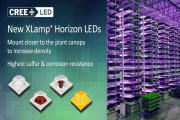In October, 2010, China’s State Council officially recognized the optoelectronics industry as one of China’s emerging industries of strategic importance, with reference to its sub-industries including new-style display devices and LED.
In 2011, the starting year of China’s 12th Five-Year Plan, CCID Consulting launched China Optoelectronics Industry Layout White Paper to facilitate China’s central and local governments in their layout planning of the industry, based on CCID Consulting’s analysis of China's optoelectronics industry (with an emphasis on the LCD and LED sectors) covering the aspects of layout, industrial characteristics and route of relocation as well as its forecasts on the industry’s future trends.
Four Clusters
As the layout of China's optoelectronics industry by output value in 2010 indicates, the flat display sector feature four clusters in the Bohai Rim, the Yangtze River Delta, the Pearl River Delta and Midwestern China, while the LED features three key areas in the Bohai Rim, the Yangtze River Delta and the Pearl River Delta.
The major cities of the Bohai Rim optoelectronics cluster, namely Beijing, Tianjin, Dalian and Jinan, are supporting the industry’s development and upgrade with their leading scientific and research capabilities.
The Yangtze River Delta contains China’s largest optoelectronics cluster and stands in the leading position in R&D, manufacturing and application. China’s biggest LCD module bases are located in the Yangtze River Delta cities of Suzhou, Shanghai and Nanjing. It is also among China’s first batch of regions where the LED industry sees a debut, and currently holds two state-level semiconductor lighting bases in Shanghai and Yangzhou.
The Pearl River Delta is an important production base of complete electronic sets in China, especially LED products. It is also China’s biggest LED packaging base, with Guangdong Province’s output accounting for around 70% of the national total and 50% of the world total.
Boosted by favorable governmental policies, cities in Midwestern China including Nanchang, Hefei, Wuhan and Chengdu have been qualified for taking over the electronic manufacturing capacities from the Yangtze River Delta and the Pearl River Delta.
“Two Belts”
Due to the resource shortage in the eastern coastal areas and the guidance of the national policies, China’s optoelectronics industry is seeing an accelerating relocation westward, forming the Central Belt ranging from Chengdu in the west to Hefei in the east and the Eastern Belt ranging from Dalian in the north to Zhuhai in the south.
Taking Over Optoelectronics Capacities from Abroad
As the global electronic information capacities continue to relocate to regions with lower cost and closer to the emerging market and as the optoelectronics industry is on a fast track of rising, the relocation of optoelectronics capacities is of higher efficiency and quality. With the absorption of relocated capacities from abroad, the size of China’s optoelectronics industry continues to expand, while the industrial structure is expected to be optimized.
From Coastal to Inland Areas
The optoelectronics industry requires a large amount of fund, land and power resources as well as policy supports. Due to a re-configuration of the resources, China’s optoelectronics industry is seeing a relocation from the coastal areas to the inland areas. The well-developed inland cities with abundant supporting facilities will take the lead to take over the relocated optoelectronics capacities. As the optoelectronics industry in these cities continues to grow and exert an increasing influence on the periphery industries, the layout of China’s will experience a great leap.
Local Governments to Drive Industrial Consolidation
As the optoelectronics industry features high technical and capital investment, China’s local governments have been playing a significant role in the allocation of fund and land resources and policy supports, especially at the early stage of the industry’s development. Therefore, the local governments that are determined to develop the optoelectronics industry will help consolidate the industry in certain areas of China.
Differentiated Development in Different Regions
In the process of the industrial consolidation, different regions will focus on different areas of the industry under the state’s guidance to ultimately achieve a highly scientific and efficient layout.
About CCID Consulting Co., Ltd.
CCID Consulting Co., Ltd. (hereinafter known as CCID Consulting), the first Chinese consulting firm listed in the Growth Enterprise Market (GEM) of the Stock Exchange of Hong Kong (HKSE: 08235) and the first consulting firm which gets ISO 9001 international and national quality management system standard certification, is directly affiliated to China Center for Information Industry Development (hereinafter known as CCID Group). Headquartered in Beijing, CCID Consulting has so far set up branch offices in Shanghai, Guangzhou, Shenzhen, Wuhan and Chengdu with over 300 professional consultants after many years of development. The company’s business scope has covered over 200 large and medium-sized cities in China. With its powerful industrial resources, information technology and data channels, CCID Consulting provides customers with public policy establishment, industry competitiveness upgrade, development strategy and planning, marketing strategy and research, HR management, IT programming and management services. The company's customers range from industrial users in electronics, telecommunications, energy, finance and automobile to government departments at all levels and diversified industrial parks. CCID Consulting commits itself to becoming China's No.1 advisor for enterprise management, No.1 consultancy for government decision and No.1 brand for informatization consulting.





 CN
TW
EN
CN
TW
EN




